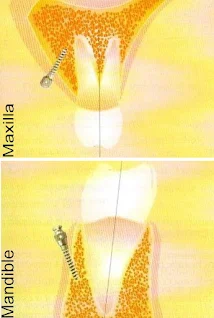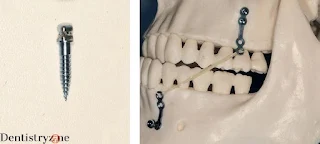Mini Implants are the anchorage devices required to fulfil the need for absolute anchorage. It is used in conditions for moving of large segment of
What are Mini Implants?
Mini Implants are the anchorage devices required to fulfil the need for absolute anchorage. It is used in conditions for moving of large segment of the tooth without any counter-movements. But these counter-movements are seen using other orthodontic or orthopaedic appliances.
It cannot be used in all patients, because it depends upon various factors including the bone sites, anatomical sites located adjacent to the anchorage site, cortical bone quantity and quality, age, gender and Mini Implant factors including length, diameter, material, and surface.
The term "Mini Implants” is interchangeably used with Micro implants, Mini screws, Skeletal Anchorage devices, Orthodontic implants or Micro screws, and Temporary Anchorage devices (TAD).
TYPES OF MINI IMPLANTS
Classified according to the
- Method of Placement
|
SELF TAPPING |
SELF DRILLING |
|
Used in the small diameter mini implants |
Used in large-diameter mini-implants |
|
1st drill is made and then a mini implant is inserted |
The mini implants itself drilled into the bone while inserting |
- Exposure of the Implant head
|
OPEN METHOD |
CLOSED METHOD |
|
The mini-implant head is exposed to the oral cavity |
The mini-implant head is not exposed to the oral cavity |
|
It is used in places where there are immoveable soft tissues such as Attached gingiva |
It is used in places where there are moveable soft tissues |
- Angle/ Path of Insertion
|
OBLIQUE DIRECTION |
PERPENDICULAR DIRECTION |
|
The mini implant is inserted at an angle of 30- 60 degrees to the long axis of the tooth |
The mini implant is inserted at an angle of 90 degrees to the long axis of the tooth |
|
It is used when the Inter-radicular bone is narrow |
It is used when there is sufficient inter-radicular bone |
SITES FOR PLACEMENT OF MINI-IMPLANTS
|
MAXILLA |
INDICATION |
|
Maxillary tuberosity |
For retraction of maxillary posterior teeth |
|
Infrazygomatic crest area |
For retraction of the maxillary anterior & intrusion of maxillary posteriors |
|
Bucally between maxillary 1st & 2nd molars |
For retraction of maxillary anterior & intrusion of maxillary molars |
|
Bucally between maxillary 1st molar & 2nd premolar |
For retraction of the maxillary anterior & intrusion of buccal teeth |
|
Bucally between maxillary canine & 1st premolar |
Mesial and Distal movements of maxillary molars & intrusion of maxillary buccal teeth |
|
Labially between maxillary incisors |
Intrusion and Torque control between maxillary incisors |
|
Palatally between 2nd premolar & 1st molar |
Retraction of maxillary anterior & intrusion of maxillary molars |
|
Midpalatal area |
For correction of unilateral crossbite |
|
MANDIBLE |
INDICATION |
|
Retromolar region |
For uprighting mandibular molars & retracting mandibular teeth |
|
Bucally between 1st & 2nd molars |
Intrusion & Distal movement of mandibular molars and retraction of mandibular anterior |
|
Bucally between 1st molar & 2nd premolars |
Intrusion of mandibular molars & retraction of mandibular anterior |
|
Bucally between mandibular canine & premolars |
Protraction of mandibular molars |
|
Facially in the symphysis region |
For intrusion of mandibular anterior |
SIZE OF MINI IMPLANTS
The mini implants are easily inserted into the various parts of the maxilla and mandible due to their small size in diameter and length. The size of mini implants ranges from 6-12mm in length & 1.2mm- 2mm in diameter. The length of the mini implant inserted into the bone ranges from 4 mm to 6 mm.
The procedure for the insertion of mini implants is slightly invasive and requires only topical anesthesia. Most times the mini implants are inserted through the gingival and into the bone with the help of a hand driver.
In cases of thick soft tissues and dense cortical bone, the mucosal punch and pilot drill are done which helps in guiding the insertion of the mini implants. These mini implants are retained mechanically to the cortical bone and loaded immediately.
ANGLE OF INSERTION OF MINI IMPLANTS
In the maxilla, the mini implants are inserted at an angle of 30-40 degrees, and in the mandible, it is inserted at an angle of 20-60 degrees to the long axis of the tooth. The rationale for the above-recommended angles is to engage the mini implants with cortical bone and away from the root structure.
 |
| Maxillary & Mandibular mini implants |
MORPHOLOGY OF MINI IMPLANTS
The shape of mini implants includes four types are Screw, Plate, Disk and Blade. The screw and plate-shaped mini implants are most commonly used. It consists of head, neck, collar and body. The central core of the mini implants comes in different shapes cylindrical and tapered. In the tapered type, there is a gradual decrease in shape from head to tip while it is the the same taper in cylindrical form.CHARACTERISTICS OF ORTHODONTIC TADs
MECHANICAL CHARACTERISTICS OF ORTHODONTICS TADs
COMPLICATIONS OF ORTHODONTIC MINI IMPLANTS (TADs)
The complications include fracture of mini implants, soft tissue inflammation, root contact or penetration, and failure of orthodontic TADs.
Root contact or penetration is caused by inadequate inter-radicular spaces, incorrect inclination of the insertion, and failure in analyzing the bone thickness and distance between the bone and roots. Soft tissue inflammation is due to inadequate oral hygiene and presents as redness and swelling.
Fracture of TADs is due to over-torque during insertion or removal. It can be reduced by proper insertion techniques and the selection of correct-sized TADs. Failure of mini implants is due to decreased clinical stability which causes the loosening of mini implants. The solution is the removal of old mini implants and replacement with new mini implants.
 |
| The image shows mini-implant failure caused due to loosening by displacement of elastics. |
















COMMENTS